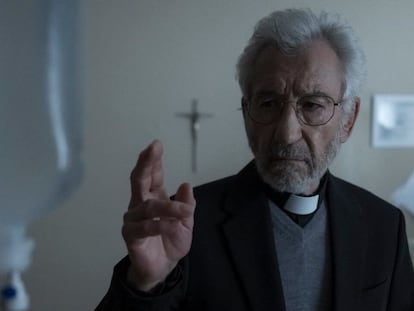Cannibalism returns to film: ‘No one likes to be told that their ancestors ate their neighbors’
With ‘Bones And All’ in theaters and a new J.A. Bayona production about the Andes tragedy on its way, the anthropophage is more alive than ever on our screens

The 1928 documentary Gow the Head Hunter was the first movie to present cannibalism on screen. Filmed by the explorer Captain Edward A. Salisbury, with photography direction by Merian C. Cooper and Ernest B. Schoedsack (who would create King Kong five years later), the film did not explicitly illustrate the ingestion of human meat, but it did document the preparations and rituals of natives who continued the practice. Starting with that pioneering work, the essayist Antonio José Navarro has traced the history of the figure of the cannibal in film in the book El banquete infame. Representaciones del canibalismo en el cine (or, The infamous banquet. Representations of cannibalism in cinema), which analyzes the phenomenon from the perspective of cultural studies.
Navarro, a critic and film historian, grew interested in the topic as he worked on his previous book, which explored fear in North American horror films after 9/11. “I realized that the theme of cannibalism was very common in horror films from the United States, from the 1970s on, and in the era that I addressed in that book, it began to reappear,” he says. With a star like Timothée Chalamet currently on screen devouring his peers, in the teen drama Bones And All, the cannibal’s prevalence in the collective imagination is clear. Shows like Yellowjackets have also taken on the theme. Next year will bring the release of the film Society of the Snow, J. A. Bayona’s examination of the 1972 tragedy in the Andes, in which the survivors of Uruguayan Air Force Flight 571 resorted to anthropophagy to stay alive (a story already recounted in the 1993 hit Alive).

“Cannibals in film are almost always depicted as an anomaly,” Navarro explains. “Or as the other, as something strange, as our savage counterpart. At its root, that is the monstrosity. It gives fertile ground for each individual’s ideas about the world. For example, Cannibal Holocaust (1980), which is an extremely violent, unpleasant film, and with scenes that are still hard to watch today, knowing that some used special effects and others didn’t [the animal deaths are real], is also a shamelessly political film, which discusses colonialism, the remains of civilization as it penetrates nature and in its contact with primitive peoples, who are simply our own reflection. The political and moral reading is clear: it is the civilized white men who kill animals cruelly and gratuitously, because they don’t even eat them. It denounces the supposed civilization that wreaks destruction in search of fame, money, energy resources. Just like the Nazis, who brought about the worst atrocities imaginable, they were people with a great culture. What the director, Ruggero Deodato, tells us is terrifying: that rather than mitigating those instincts, our entire civilization strengthens them. It is a very revolutionary film, a precursor of the false documentary. But decades passed before a series of critics dared to dignify that product, which is not at all innocuous or innocent.”
Question. Is there still a taboo when speaking about cannibalism from a historical perspective?
Answer. Clearly. No one likes to be told that their ancestors ate their neighbors, but it is scientifically demonstrated. Most of our ancestors ate their neighbors, as shown by the fact that, in three quarters of the population, there has been a mutation detected that prevents us from getting sick if we eat a person. According to archaeological evidence, primitive humans did not only eat others out of necessity, but they also did it for pleasure, because they must have found them tasty. That breaks with the moral schemas of all human societies, but it is a reality. Cannibalism is common in nature. There is no malice in it. We give it malice with our gaze. It follows natural laws that depart from what we conceive as culture and civilization.
Q. Does the rejection of cannibal films as something in bad taste also obey that perception?
A. For many decades, there has been an attempt to gentrify film, to ennoble it. So there are certain issues that seem like they shouldn’t be touched. Any film that takes on the topic of cannibalism and goes into depth, even with intentions of social or political critique, is automatically considered to be something low-class. All of this has a cultural expression that has been silenced so as not to degrade us. The discoveries in Atapuerca confirm our ancestors’ cannibalistic practices, but they have been given little importance. You have to look for it if you want to find it. Not to mention religious rituals around the world that involve the ingestion of sacrificed people or even people who symbolize God himself. In a mass, we ingest the body and blood of Christ. We do it symbolically, but to acquire, as Freud said, the qualities of that God who we are venerating by eating his body.

Q. Does culture, in a way, work to channel those impulses?
A. Culture is a product of civilization, which was created to dominate, control and repress those impulses. What happens is that they always end up coming out one way or another. Of course, there is an abyss between painting a canvas, writing a novel or making a movie and eating a person. But I’m surprised by the quantity of literary, visual, mythological and psychological sources that speak of cannibalism as an element that is integrated in our daily language without us realizing it. Vulgar expressions referring to sex, like, “I’m going to eat your whatever!,” or when you have your child or little nephew in your arms and you say, “I’m going to eat you up!,” or when you give the other team a beating and you say “We ate them…” That demonstrates a lot.
Q. So is the idea of a cannibal like Hannibal Lecter, who is a very educated and rational character, more provocative than the archetype of the savage and instinctual cannibal?
A. Without a doubt. It is an idea that hasn’t been explored much. Hannibal Lecter is an overly civilized man. His culture, his philosophy, his knowledge of how to be in the world, have given him an absolutely cynical and credulous perspective that brings him to break with all taboos. That’s why he eats his patients and everyone who bothers him, like the famous census official whose liver he eats with fava beans and a Chianti. He is a super-intelligent person who, in a way, opts out of the civilized values that he seemed to incarnate. In that way, he is extremely provocative.
Q. Cannibals in film began as caricatures of racialized people, but later, the trend is for them to represent the conservative United States. Was there a subversive intention in that evolution?
A. Filmmakers like George A. Romero [director of Night of the Living Dead, 1968] and Tobe Hooper [director of The Texas Chainsaw Massacre, 1974] had urban educations and were on the left, so yes, they did it with a totally subversive intention. That deep America full of hillbillies and rednecks was, for them, a symbol of all of the evils of the United States. They are Republicans, from the Bible Belt, the cult of firearms, so the worst thing that can happen to you is being an urbanite, getting lost there, for them to find you and eat you. Devouring the protagonist who comes from the city is an act of supreme destruction, because they convert them into pure meat, into prisoners. There is a rejection of that mentality of the United States that has provided material for a lot of movies.
Q. Is there also a sexual dimension to cannibalism? You briefly mention the case of the Rotenburg cannibal, who in 2001 murdered and ate a man with the victim’s consent.
A. The act of eating someone you love or desire sexually could be seen as the ultimate act of possession and assimilation, because the other person becomes part of your body. In modern psychology, they speak of “cute aggression,”which refers to when you bite or scratch your partner or your partner does so to you. That isn’t an act of violence tinged with cruelty or sadism, it’s a form of expressing love and desire, with a touch of subliminal cannibalism. In the case of the Rotenburg cannibal, during the trial there were certain dilemmas that went beyond the law. There was a tacit agreement between those people. One wanted the other to kill him and eat him. But the State, even if you want to be killed and eaten, has the obligation to protect you, so the other person is automatically a criminal.
Q. Doesn’t filling cannibalism with cinematographic connotations and metaphors diminish its impact?
A. I don’t think one contradicts the other. Ultimately, cannibalism is not just the act of ingesting human meat. It has certain implications, and that’s where all the metaphorical possibilities come in. Not just anyone participates in the cannibal banquet. Not just anyone is eaten, and just not any part of that person is eaten. What happens is that the metaphor loses impact if it is not represented clearly, so that we understand what the act of cooking, cutting up and eating a person means. For example, Raw (2016) is made with a certain distance that I think undermines its treatment of the topic. Eating a person is not an issue from which you can maintain distance. The core of the issue is how to break that taboo, that mental barrier, and come to accept as normal for survival something that in your society would be totally abnormal. For example, with the history of the Uruguayan rugby team in the Andes, I always make a distinction between the American version by Frank Marshall, Alive, and the Mexican one by René Cardona, Survive!, which seems much more honest to me.
Q. What is the big difference?
A. The American film centers on the heroism of the young people who survived and crossed the mountains to get help. But that isn’t the issue. The issue is the process of coming to eat your friend to survive. The survivors of the Andes even followed a ritual. They didn’t eat certain parts of the body. They dismembered them with the strictest privacy.
Q. Would you say that there has been an evolution in the subgenre and the sophistication of its arguments?
A. In recent years there has been greater sophistication, but more formal than thematic. There are supposedly intellectual films that seek justifications that aren’t instinctual or primitive, that aren’t on the dark side of the human mind. On the other hand, some like In My Skin (2002) or Trouble Every Day (2001) are more visceral films. In My Skin is extremely disturbing to me. It uses autocannibalism to expose a series of really unsettling issues about violence against women. Cannibals in film will not disappear. They will change and mutate with society, but I don’t think that today is any better or worse than in other eras. It’s different. Now issues are presented that wouldn’t have appeared years ago.
Sign up for our weekly newsletter to get more English-language news coverage from EL PAÍS USA Edition
Tu suscripción se está usando en otro dispositivo
¿Quieres añadir otro usuario a tu suscripción?
Si continúas leyendo en este dispositivo, no se podrá leer en el otro.
FlechaTu suscripción se está usando en otro dispositivo y solo puedes acceder a EL PAÍS desde un dispositivo a la vez.
Si quieres compartir tu cuenta, cambia tu suscripción a la modalidad Premium, así podrás añadir otro usuario. Cada uno accederá con su propia cuenta de email, lo que os permitirá personalizar vuestra experiencia en EL PAÍS.
¿Tienes una suscripción de empresa? Accede aquí para contratar más cuentas.
En el caso de no saber quién está usando tu cuenta, te recomendamos cambiar tu contraseña aquí.
Si decides continuar compartiendo tu cuenta, este mensaje se mostrará en tu dispositivo y en el de la otra persona que está usando tu cuenta de forma indefinida, afectando a tu experiencia de lectura. Puedes consultar aquí los términos y condiciones de la suscripción digital.
More information
Archived In
Últimas noticias
Welcome to the post-religion era: The idea of Christianity as the absolute truth has become obsolete
‘I thought you would like it’: The risky sexual practice popularized by TV shows and TikTok
The digitalization of tourism: ‘They promise experiences and gave us the worst possible one’
Mexican peso defies uncertainty with forecasts of a new period of stability in 2026
Most viewed
- Sinaloa Cartel war is taking its toll on Los Chapitos
- Oona Chaplin: ‘I told James Cameron that I was living in a treehouse and starting a permaculture project with a friend’
- Reinhard Genzel, Nobel laureate in physics: ‘One-minute videos will never give you the truth’
- Why the price of coffee has skyrocketed: from Brazilian plantations to specialty coffee houses
- Silver prices are going crazy: This is what’s fueling the rally











































